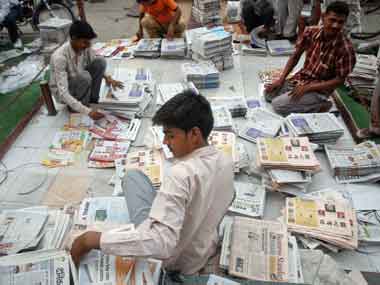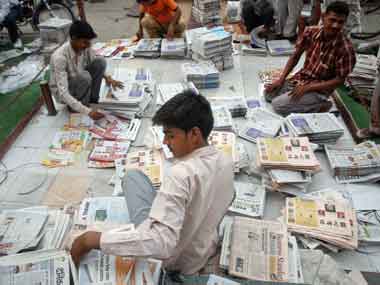“Our free media, including our largely unfettered press, are a hugely important asset for democratic India. And yet the celebration of the Indian news media can go only so far — and no further. There are at least two barriers to quality that need to be overcome. The first is some real laxity in professionalism in achieving accuracy. The second is the bias, often implicit, in the choice of what news to cover and what to ignore, and the way this bias relates particularly to class divisions in India,” says the introduction to Dr. Amartya Sen’s editorial comment in The Hindu.
The editorial goes on to expand on these two barriers that Dr. Sen highlights
. [caption id=“attachment_175434” align=“alignleft” width=“380” caption=“All of India’s key newspapers get substantial revenue from the govt. PTI”]
 [/caption] The edit is a must read and one that all editors should view as a mirror. Yet, the editorial makes some assumptions that ignore some critical dynamics in the Indian news media space. I’ll spend little or no time on the laxity of professionalism which results in inaccuracies. This is caused by an overall shortage of talent, an issue that all industries in India are grappling with. Dr. Sen refers to news media as ‘our free and vibrant press’ in the first paragraph of his commentary – and this is where the crux of the problem in Indian news media lies. The press is only seemingly free and unfettered – largely, it is deceptively so. The bias that Dr. Sen refers to is due to a combination of ‘fetters’ unseen and the unique business model that is prevalent in Indian newspapers. A bit of history – the first fetters Newspapers in India could not be launched without immediately being beholden to the government. The first obligation was when you were, simply, allowed to launch a newspaper, which is no easy task even today. Getting the name registered with the Registrar of Newspapers India was the first step in your ambitions to launch a paper. The second step, far more obligatory in nature, was to get a newsprint quota. The third was to get licenses to import printing machinery. How can this be a free and unfettered press when your very existence depended on the whims and fancies of the government in power? The newsprint quota and the licenses to import machinery were the tools that the government used to keep newspapers in check. Step out of line, and there goes the quota. To compound matters, in many states across the country, power supply was unreliable. Who do you go to when you ask for uninterrupted power? The government, of course. The unique Indian business model and the next ‘fetters’ It was the license raj that forced an unusual business model in India. Major newspapers largely enjoyed monopolistic status, controlling geographies where they were kings. In such a situation, where, for example, The Hindu ruled Chennai, The Statesman ruled Kolkata, The Times of India ruled Mumbai and The Hindustan Times ruled New Delhi, the advertisers had little or no choice – and the market was a seller’s, rather than a buyer’s, market. Newspapers took the easy route to transfer costs of production and their targeted profits to the advertiser rather than the reader and made Indian newspapers ridiculously cheap even compared to Bangladesh (
The Daily Star costs 10 Taka with a pagination of 24
) – immediately creating an uneasy relationship and obligation to the advertisers. Government advertising, once the Directorate of Advertising and Visual Pubnlicty (DAVP) was formed with the authority to release ads in newspapers and TV channels, for all central government establishments became a carrot or stick, depending on how the newspaper was perceived by the party in power. How important is government advertising to newspapers? In 2009-10, for example, The Times of India received as much as Rs. 34 crore from the DAVP, The Hindustan Times Rs. 25 crore, Dainik Jagran Rs. 11 crore, Dainik Bhaskar Rs. 10 crore and The Hindu, Rs. 9 crore.
You can see details of the top beneficiaries of DAVP’s largesse here
. The ‘freedom’ of the press is a misnomer, dependent as newspapers are on advertising, both government and private. In many instances, the bias that Dr. Sen refers to creeps in unconsciously, but in many instances, the bias is a result of the fear of losing advertising revenue. The future What Dr. Sen refers to as a largely free and unfettered media is a media we might increasingly see in the years ahead. The first signs of unfettering came with the reforms initiated in 1991, resulting in the dismantling of the license raj and the opening up of imports. With two critical elements out of the mix, what is left is for media owners to bite the bullet and transfer more of the costs to the reader rather than to the advertiser. It’s only when this ratio – the advertising revenue: circulation revenue ratio – changes significantly can the issue of bias be addressed. Till then, a free and unfettered press will remain words that are eminently quotable – but eminently misused.
[/caption] The edit is a must read and one that all editors should view as a mirror. Yet, the editorial makes some assumptions that ignore some critical dynamics in the Indian news media space. I’ll spend little or no time on the laxity of professionalism which results in inaccuracies. This is caused by an overall shortage of talent, an issue that all industries in India are grappling with. Dr. Sen refers to news media as ‘our free and vibrant press’ in the first paragraph of his commentary – and this is where the crux of the problem in Indian news media lies. The press is only seemingly free and unfettered – largely, it is deceptively so. The bias that Dr. Sen refers to is due to a combination of ‘fetters’ unseen and the unique business model that is prevalent in Indian newspapers. A bit of history – the first fetters Newspapers in India could not be launched without immediately being beholden to the government. The first obligation was when you were, simply, allowed to launch a newspaper, which is no easy task even today. Getting the name registered with the Registrar of Newspapers India was the first step in your ambitions to launch a paper. The second step, far more obligatory in nature, was to get a newsprint quota. The third was to get licenses to import printing machinery. How can this be a free and unfettered press when your very existence depended on the whims and fancies of the government in power? The newsprint quota and the licenses to import machinery were the tools that the government used to keep newspapers in check. Step out of line, and there goes the quota. To compound matters, in many states across the country, power supply was unreliable. Who do you go to when you ask for uninterrupted power? The government, of course. The unique Indian business model and the next ‘fetters’ It was the license raj that forced an unusual business model in India. Major newspapers largely enjoyed monopolistic status, controlling geographies where they were kings. In such a situation, where, for example, The Hindu ruled Chennai, The Statesman ruled Kolkata, The Times of India ruled Mumbai and The Hindustan Times ruled New Delhi, the advertisers had little or no choice – and the market was a seller’s, rather than a buyer’s, market. Newspapers took the easy route to transfer costs of production and their targeted profits to the advertiser rather than the reader and made Indian newspapers ridiculously cheap even compared to Bangladesh (
The Daily Star costs 10 Taka with a pagination of 24
) – immediately creating an uneasy relationship and obligation to the advertisers. Government advertising, once the Directorate of Advertising and Visual Pubnlicty (DAVP) was formed with the authority to release ads in newspapers and TV channels, for all central government establishments became a carrot or stick, depending on how the newspaper was perceived by the party in power. How important is government advertising to newspapers? In 2009-10, for example, The Times of India received as much as Rs. 34 crore from the DAVP, The Hindustan Times Rs. 25 crore, Dainik Jagran Rs. 11 crore, Dainik Bhaskar Rs. 10 crore and The Hindu, Rs. 9 crore.
You can see details of the top beneficiaries of DAVP’s largesse here
. The ‘freedom’ of the press is a misnomer, dependent as newspapers are on advertising, both government and private. In many instances, the bias that Dr. Sen refers to creeps in unconsciously, but in many instances, the bias is a result of the fear of losing advertising revenue. The future What Dr. Sen refers to as a largely free and unfettered media is a media we might increasingly see in the years ahead. The first signs of unfettering came with the reforms initiated in 1991, resulting in the dismantling of the license raj and the opening up of imports. With two critical elements out of the mix, what is left is for media owners to bite the bullet and transfer more of the costs to the reader rather than to the advertiser. It’s only when this ratio – the advertising revenue: circulation revenue ratio – changes significantly can the issue of bias be addressed. Till then, a free and unfettered press will remain words that are eminently quotable – but eminently misused.
Anant Rangaswami was, until recently, the editor of Campaign India magazine, of which Anant was also the founding editor. Campaign India is now arguably India's most respected publication in the advertising and media space. Anant has over 20 years experience in media and advertising. He began in Madras, for STAR TV, moving on as Regional Manager, South for Sony’s SET and finally as Chief Manager at BCCL’s Times Television and Times FM. He then moved to advertising, rising to the post of Associate Vice President at TBWA India. Anant then made the leap into journalism, taking over as editor of what is now Campaign India's competitive publication, Impact. Anant teaches regularly and is a prolific blogger and author of Watching from the sidelines.
)